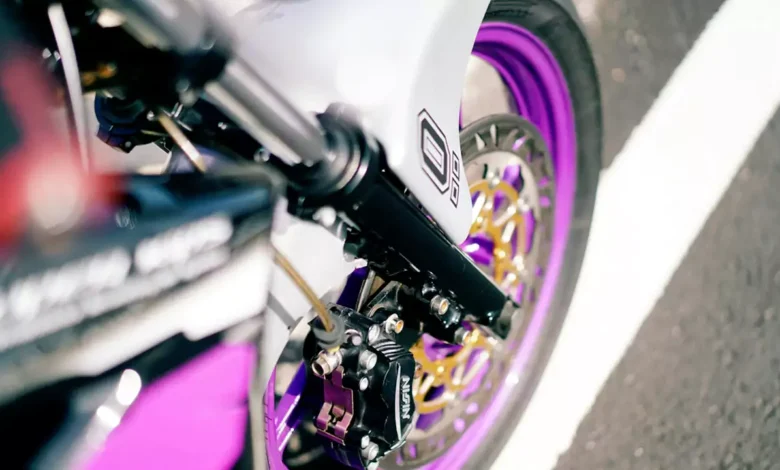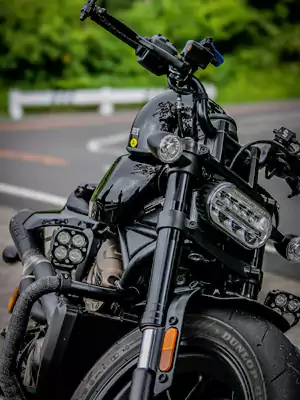Motorcycle Suspensions: A Detailed Analysis of All the Types

Motorcycle suspensions are crucial for a comfortable ride, maintaining control, and ensuring safety. They absorb shocks from uneven road surfaces, keeping the tyres in contact with the ground and providing stability. This article delves into the different types of motorcycle suspensions.
Highlighting their pros and cons to help you better understand how they work and what might be best for your riding needs.

Telescopic Forks
Telescopic forks are the most common type of front suspension found on motorcycles. They consist of two tubes (the upper tube called the “stanchion” and the lower tube called the “slider”) that slide into each other. Inside, they contain springs and oil, which work together to dampen shocks and smoothen the ride.
Pros
Simplicity and Reliability: Telescopic forks are straightforward in design, making them easy to maintain and reliable over long periods.
Cost Effective: Due to their popularity and simplicity, telescopic forks are generally more affordable than other suspension systems.
Wide Availability: Almost every motorcycle uses telescopic forks, meaning parts and servicing are widely available.
Lightweight: Their design contributes to a lighter front end, which is beneficial for handling and manoeuvrability.
Cons
Limited Adjustability: Standard telescopic forks usually offer limited or no adjustability for damping and preloading. High-end versions may include these features, but they are more expensive.
Nose Dive Under Braking: Telescopic forks can cause significant frontend dives under heavy braking, which can unsettle the bike and affect handling.
Wear and Tear: The seals and bushings within the fork tubes can wear out over time, leading to leaks and reduced performance.
UpsideDown (USD) Forks
Upsidedown (USD) forks are an advanced variation of the traditional telescopic fork. The design is essentially inverted, with the thicker, more rigid part of the fork at the top and the thinner part at the bottom. This setup improves stiffness and handling, especially in highperformance motorcycles.
Pros
Enhanced Rigidity: The inverted design increases frontend stiffness, improving handling and stability, particularly during aggressive cornering and braking.
Reduced Unsprung Weight: USD forks reduce unsprung weight, which improves the suspension’s ability to react to road surface changes quickly.
Better handling: The increased rigidity and reduced weight contributes to better overall handling, making them ideal for sportbikes and high-performance motorcycles.
Cons
Cost USD forks are generally more expensive to produce and maintain than standard telescopic forks, making them more common on high-end motorcycles.
Complexity: The more complex design can make maintenance and repairs more challenging and costly.
Overkill for Casual Riders: For everyday riders who don’t push their bikes to the limits, the benefits of USD forks may not justify the extra cost.
DualShock Rear Suspension
The dualshock rear suspension system, commonly known as twinshock, is an older design where two shock absorbers are mounted on either side of the rear wheel. This system was widely used in motorcycles until the late 1970s and is still seen on some classic or retrostyled bikes.
Pros
Classic Aesthetic: Dualshock systems provide a vintage look, which is appealing to enthusiasts of classic or retro motorcycles.
Simplicity: The straightforward design makes them easy to maintain, with readily available parts.
Durability: Dual shocks are robust and can handle a lot of abuse, making them suitable for bikes that frequently carry heavy loads or navigate rough terrains.
Cons
Limited Performance: Compared to modern suspension systems, dual shocks offer limited adjustability and less effective damping, resulting in a rougher ride.
Increased Weight: The dualshock setup adds extra weight to the rear of the motorcycle, which can negatively affect handling and acceleration.
Outdated Technology: While still functional, dualshock systems are largely outdated and don’t offer the performance benefits of more modern suspension types.
MonoShock Rear Suspension
The monoshock rear suspension system uses a single shock absorber, typically located under the seat and connected to the swingarm. This design has become the standard for most modern motorcycles, especially those designed for high performance.
Pros
Superior Damping: Monoshock systems offer better damping control, which leads to improved ride comfort and handling.
Adjustability Many: monoshock setups allow for easy adjustment of preload, compression, and rebound, enabling riders to finetune the suspension to their preferences and riding conditions.
Centralized Weight: Placing the shock absorber centrally helps in better weight distribution, improving overall balance and handling.
Reduced Wear: The single shock design typically results in less wear on the swingarm and frame compared to dualshock systems.
Cons
Cost: Monoshock systems tend to be more expensive than dualshock setups, both in terms of initial cost and maintenance.
Complex Repairs: The more sophisticated design can make repairs more complex and costly, especially for systems with advanced adjustability features.
Limited Aesthetic: Appeal For those who prefer the look of classic motorcycles, the monoshock design may lack the visual appeal of a dualshock setup.
Paralever Suspension
Paralever is a proprietary suspension system developed by BMW for their motorcycles. It combines the swingarm and shaft drive into a single unit, reducing the adverse effects of shaft-driven systems, such as “shaft jacking” (where the rear of the bike rises under acceleration).
Pros
Minimized Shaft Jacking: The Paralever design effectively reduces the lifting and squatting tendencies of shaft-driven motorcycles, leading to a smoother ride.
Improved Stability: By reducing these adverse effects, the Paralever suspension provides better stability and control, especially in cornering and during acceleration.
Low Maintenance: As a sealed unit, the Paralever system requires less maintenance compared to chain driven motorcycles.
Cons
Weight: The Paralever system adds significant weight to the motorcycle, which can negatively impact performance, especially in terms of acceleration and handling.
Complexity: The integration of the shaft drive with the suspension adds complexity, making repairs and maintenance more challenging.
Cost: The advanced design of the Paralever system makes it more expensive than traditional suspension systems, both in terms of initial cost and replacement parts.
Choosing the right suspension system for your motorcycle depends on your riding style, the type of roads you frequently travel, and your personal preferences. Telescopic forks and mono-shock systems offer reliability and adjustability, making them ideal for most riders. On the other hand, USD forks and Paralever suspensions cater to more specialized needs, often with increased costs and complexity. Understanding the pros and cons of each type will help you make an informed decision, ensuring that your motorcycle is equipped with the suspension that best suits your needs.
